Wildflowers of the Adirondacks:
Yellow Pond Lily (Nuphar variegata)
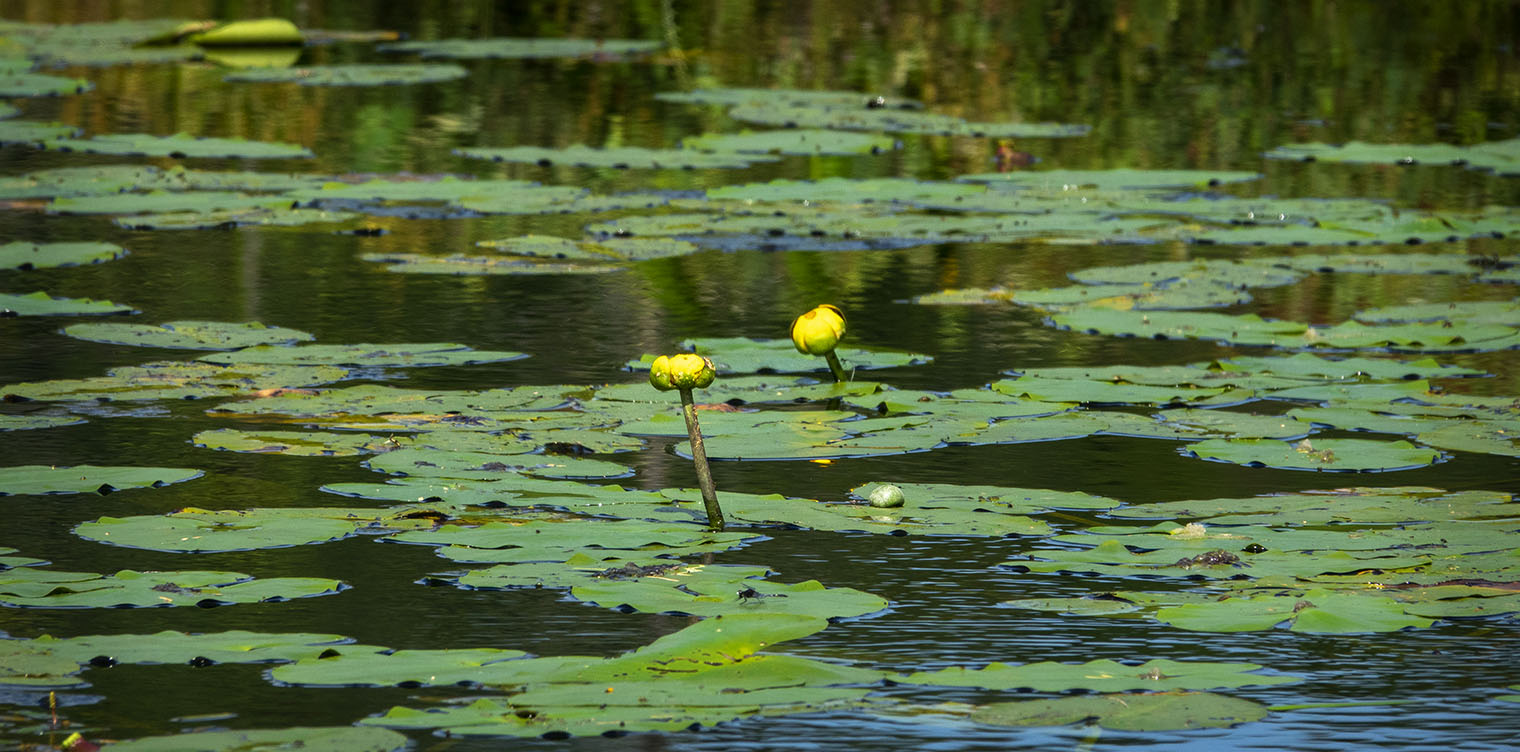
Yellow Pond Lily (Nuphar variegata) is an aquatic wildflower which produces yellow flowers in June, July, and early August in the Adirondack Mountains of upstate New York.
Yellow Pond Lily is a member of the Nymphaeaceae family, which consists of two genera: Nuphar and Nymphaea. The Nymphaea genus includes the White Water Lily, another aquatic plant often seen in similar habitats as the Yellow Pond Lily.
The taxonomy of the Nuphar genus has been revised in light of recent research, which means that different sources categorize Yellow Pond Lily differently. The current thinking, reflected in the New York Flora Atlas treatment of these plants, is that the Nuphar genus contains eight lower taxa, including four species found in the Adirondack Park:
- Yellow Pond Lily (Nuphar variegata)
- Intertidal Yellow Pond Lily (Nuphar advena)
- Small-leaved Yellow Pond Lily (Nuphar microphylla)
- Red-disked Yellow Pond Lily (Nuphar rubrodisca)
Other common names include Beaver-lily, Beaver-root, Brandy-bottle, Bullhead Lily, Bull-head Lily, Bullhead Pond-lily, Spatterdock, Common Spatter Dock, Common Spatterdock, Common Yellow Pond Lily, Cow Lily, Cow-Lily, Dog-lily, Large Yellow Pond-lily, Variegated Yellow Pond-lily, Variegated Yellow Pond-lily, Yellow Cowlily, Yellow Pondlily, Yellow Pond-lily, and Yellow Water-lily.
Identification of Yellow Pond Lily
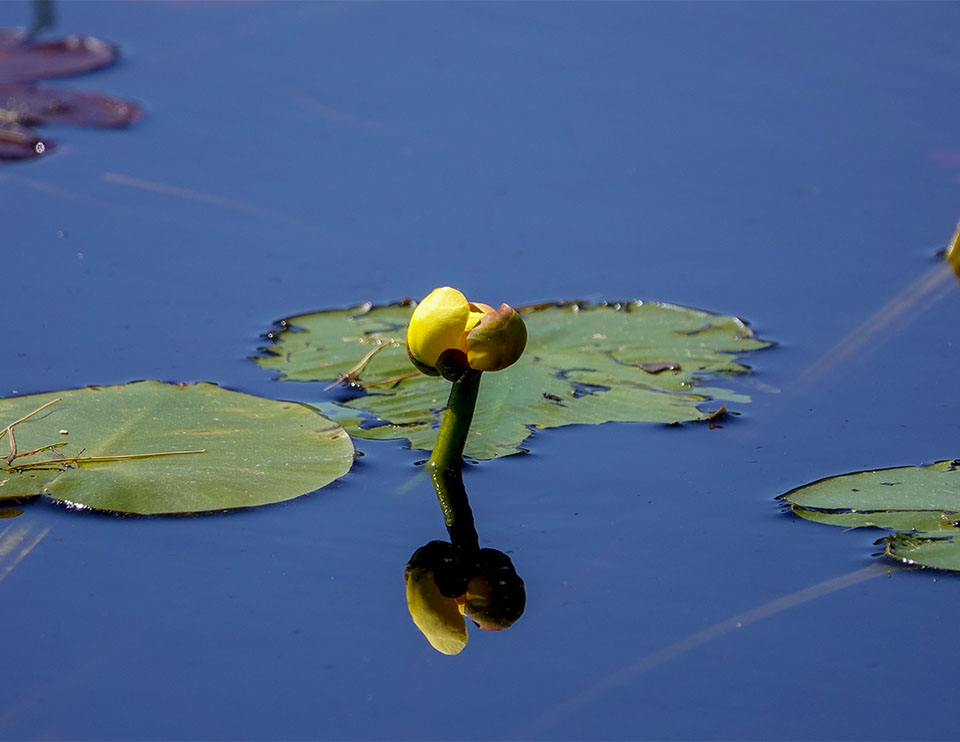
Yellow Pond Lilies are floating aquatic plants with long stalks growing from spongy rhizomes Rhizome: The modified subterranean stem of a plant that sends out roots and shoots from its nodes. Rhizomes are also called creeping rootstalks and rootstocks. anchored in the muddy bottom of a water body. The stems are slippery and often slimy to the touch.
Rhizome: The modified subterranean stem of a plant that sends out roots and shoots from its nodes. Rhizomes are also called creeping rootstalks and rootstocks. anchored in the muddy bottom of a water body. The stems are slippery and often slimy to the touch.
Yellow Pond Lily leaves are mostly floating, although occasionally submersed.
- The leaves are green, sometimes with a purple tinge.
- The leaves are alternate
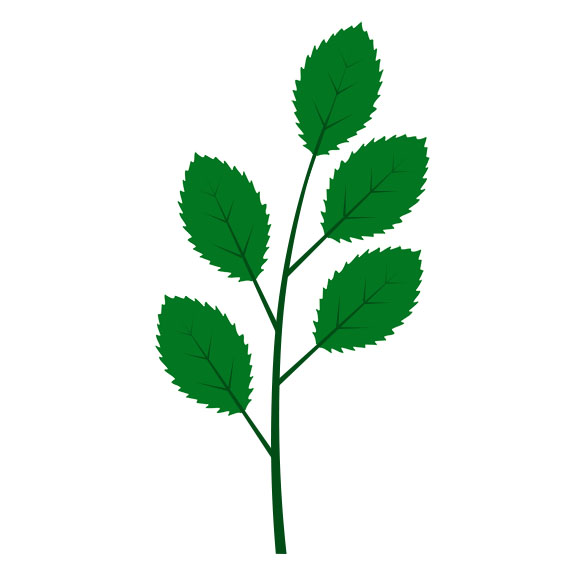 Alternate: An arrangement of leaves (or buds) on a stem (or twig) in which the leaves emerge from the stem one at a time. This often makes the leaves appear to alternate on the stem., meaning there is one leaf per node.
Alternate: An arrangement of leaves (or buds) on a stem (or twig) in which the leaves emerge from the stem one at a time. This often makes the leaves appear to alternate on the stem., meaning there is one leaf per node. - The margins (edges of the leaf) are smooth
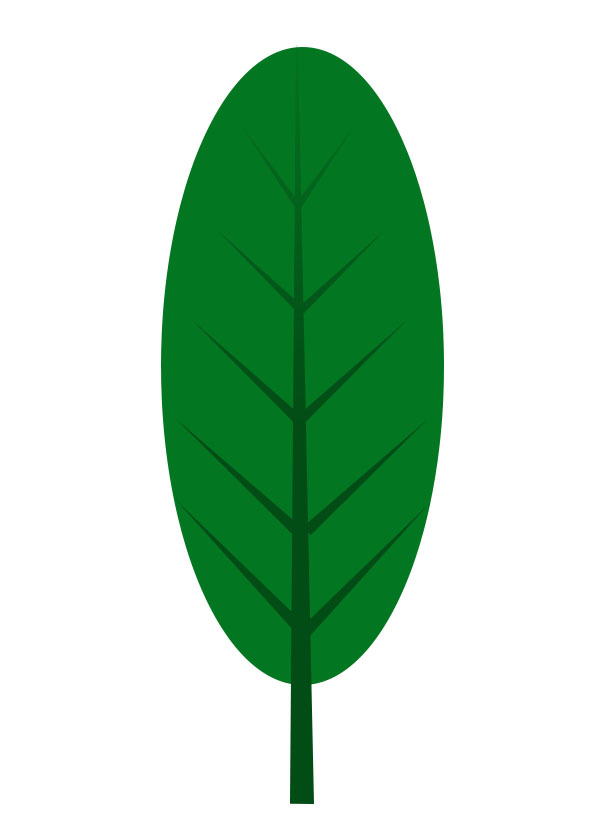 Smooth leaf edges do not have any teeth. (untoothed) and slightly wavy.
Smooth leaf edges do not have any teeth. (untoothed) and slightly wavy. - The leaves are two to six inches long, oval, with a rounded tip and a deep cleft at the base.
- The lobes
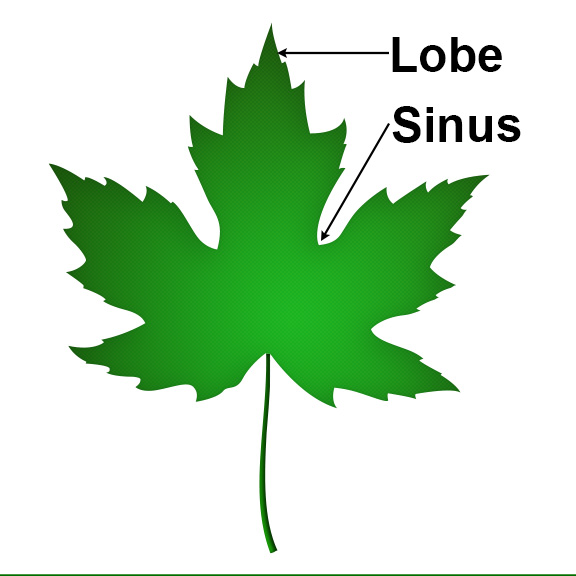 Lobe: A projection from an edge of a plant structure (such as a leaf), larger than a tooth. Lobed leaves are leaves with distinct protrusions, either rounded or pointed. sometimes overlap, with a leaf notch which is usually less than half as long as the blade's midrib
Lobe: A projection from an edge of a plant structure (such as a leaf), larger than a tooth. Lobed leaves are leaves with distinct protrusions, either rounded or pointed. sometimes overlap, with a leaf notch which is usually less than half as long as the blade's midrib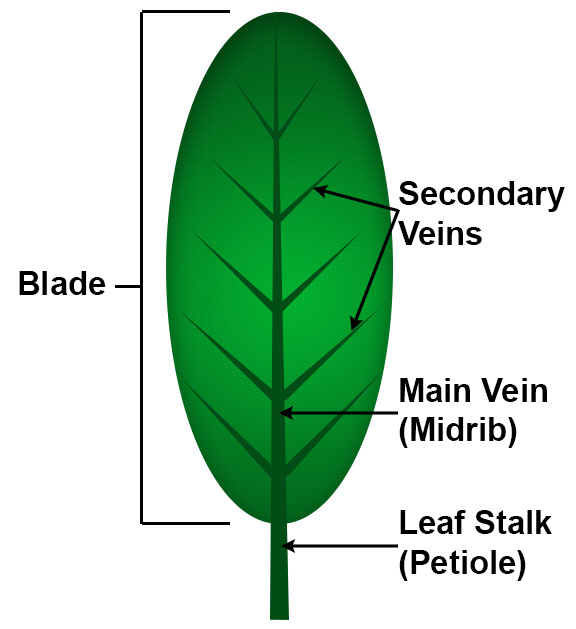 Midrib: The main or central vein of a leaf..
Midrib: The main or central vein of a leaf..
The flowers of the Yellow Pond Lily emerge on separate stalks, rising several inches above the surface of the water.
- The flowers are cup-shaped and 1½ to 2½ inches wide.
- The flowers have six petal-like sepals
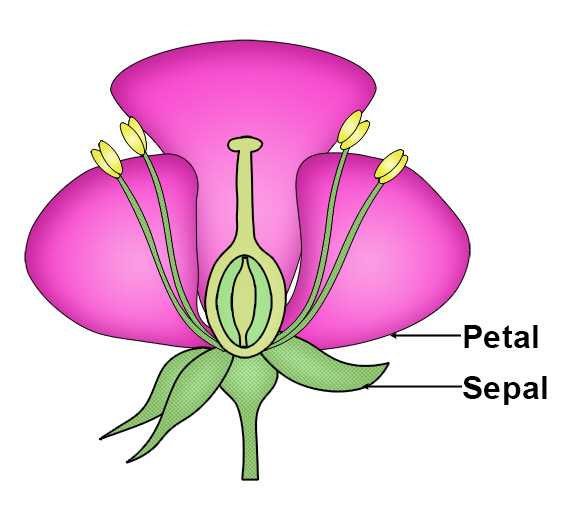 Sepal: One of the usually separate, green parts that surround and protect the flower bud and extend from the base of a flower after it has opened. and many small yellow petals resembling stamens
Sepal: One of the usually separate, green parts that surround and protect the flower bud and extend from the base of a flower after it has opened. and many small yellow petals resembling stamens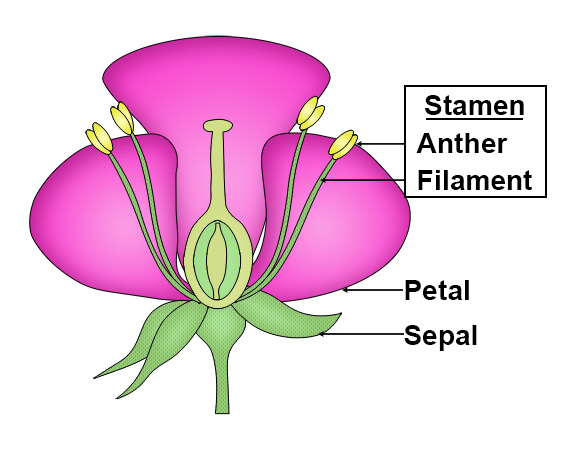 Stamen: The male part of the flower, made up of the filament and anther.. The outer surface of the flower is bright yellow, usually green near the base. The inner surface is often red or maroon near the base.
Stamen: The male part of the flower, made up of the filament and anther.. The outer surface of the flower is bright yellow, usually green near the base. The inner surface is often red or maroon near the base. - There is a yellowish disk-like stigma
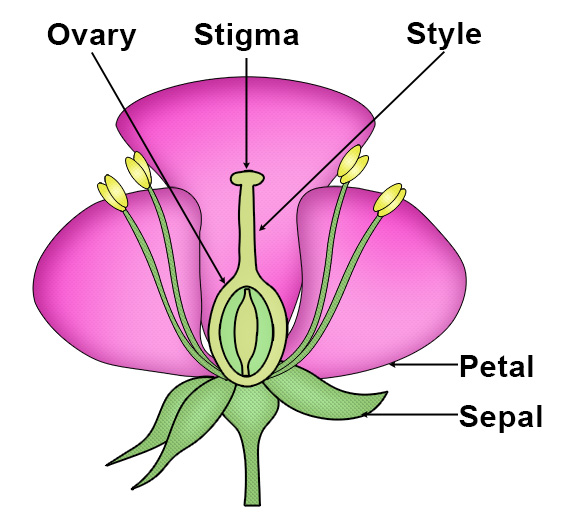 Stigma: part of the pistil, which is the seed-producing, or female, unit of a flower. The stigma is the tip of the pistil, where the pollen lands. in the center of the flower, marked with lines like the spokes of a wheel.
Stigma: part of the pistil, which is the seed-producing, or female, unit of a flower. The stigma is the tip of the pistil, where the pollen lands. in the center of the flower, marked with lines like the spokes of a wheel.
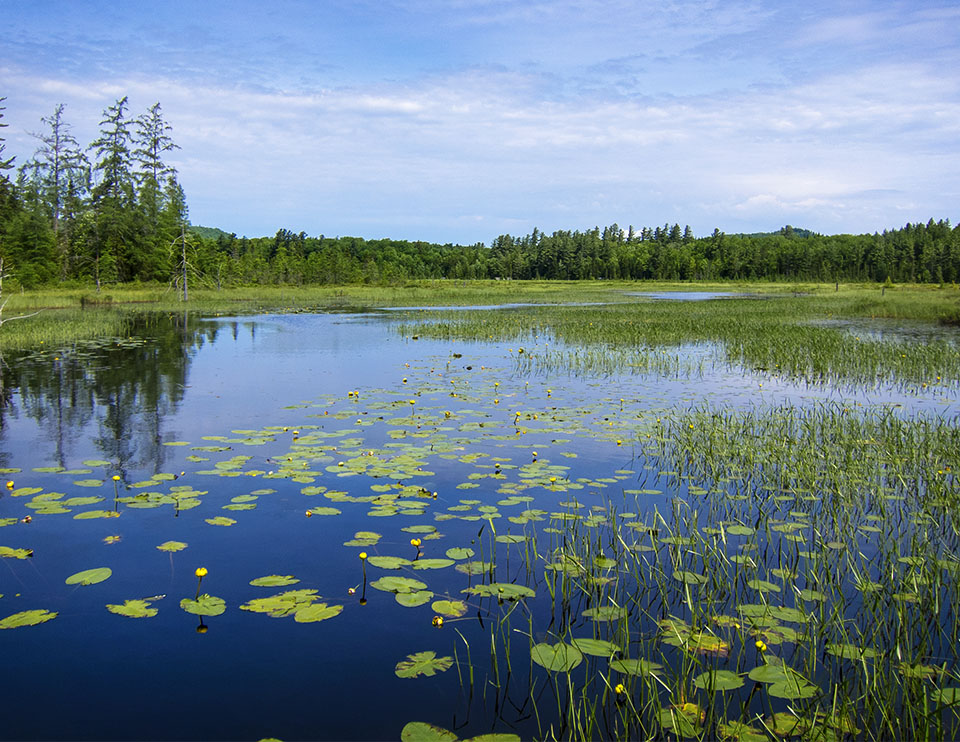
In the Adirondack Park, Yellow Pond Lilies typically bloom from early through mid-summer. A tally of flowering dates for the upland Adirondack areas compiled by Michael Kudish, based on data collected from the early seventies to the early nineties, lists a median flowering date of 5 July.
This is consistent with more recent data on flowering, which suggest that flowering for areas in the northern part of the Adirondacks begins in mid-June (early June in some years), extending through late July and early August. Bloom dates for plants in the southern parts of the Adirondack Park are somewhat earlier.
Yellow Pond Lily fruit consists of an oval capsule, up to about 1½ inches long. The capsule is ribbed and purple-tinged.
Yellow Pond Lily can be distinguished from other members of the Nuphar genus by the size of its leaves and the size and color of its flowers.
- Red-disked Yellow Pond Lily (Nuphar rubrodisca), as the name implies, has a red disk, in contrast to Yellow Pond Lily's yellow disk. For Red-disked Yellow Pond Lily, the lobes
 Lobe: A projection from an edge of a plant structure (such as a leaf), larger than a tooth. Lobed leaves are leaves with distinct protrusions, either rounded or pointed. of the leaves are about half as long as the blade's midrib
Lobe: A projection from an edge of a plant structure (such as a leaf), larger than a tooth. Lobed leaves are leaves with distinct protrusions, either rounded or pointed. of the leaves are about half as long as the blade's midrib Midrib: The main or central vein of a leaf..
Midrib: The main or central vein of a leaf.. - Small-leaved Yellow Pond Lily (Nuphar microphylla) has much smaller flowers, from ½ to ¾ inches in diameter. The leaves are much smaller than those of Yellow Pond Lily and more deeply lobed, with the sinus
 Sinus: In leaves with lobes, the indented area between two lobes. ⅔ or more the length of the midrib.
Sinus: In leaves with lobes, the indented area between two lobes. ⅔ or more the length of the midrib. - Intertidal Yellow Pond Lily (Nuphar advena) is very similar to Yellow Pond Lily, but its leaves are usually held several inches above the water. It is relatively rare within the Adirondack Park, being predominantly a species of tidal marshes along the Hudson River.
Uses of Yellow Pond Lily
Native American people used this plant as a food source, boiling or roasting the roots or drying and grinding them into meal or flowers. The roasted seeds were also eaten like popcorn.
Yellow Pond Lily also played an important role in Native American medicine. The plant was reportedly used as an analgesic and anticonvulsive by the Iroquois. Other tribes are said to have used the plant to treat a variety of ailments, including skin conditions, rheumatic pain, and heart conditions. There are also some accounts of the root being powdered and used as a poultice. At least one source warns that large doses of the root are potentially toxic.
Wildlife Value of Yellow Pond Lily
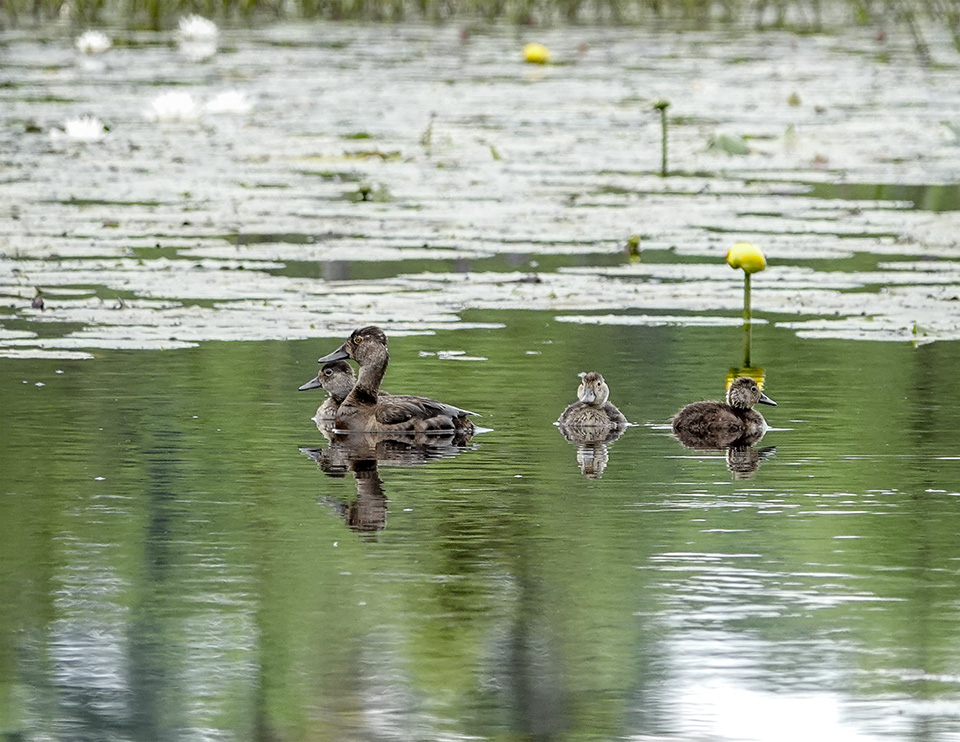
Yellow Pond Lily benefits a wide variety of wildlife. Its flowers are pollinated by flies and beetles. The plant provides food and shelter for fish, snails, crayfish, and underwater insects. Some invertebrate species reportedly spend their entire life cycle on this plant, grazing, mining, and puncturing leaf blades and roots or consuming the submersed leaves.
- The plant is a preferred host plant for several species of beetles, such as the Water-lily Leaf Beetle.
- Other insects, such as the White-tailed Diver, feed on the leaves and stems.
Yellow Pond Lily seeds are said to be an important component of the diet of Painted Turtles. These amphibians are most commonly seen sunning themselves on logs protruding from the water of slow-moving streams and marshes where Yellow Pond Lilies flourish. Common Snapping Turtles also use Nuphar species for food and cover.
Several species of birds can sometimes be seen feeding on Yellow Water Lily.
- American Black Duck ducklings feed on its seeds.
- The diet of Ring-necked Ducks is composed largely of vegetative material, especially the seeds of aquatic plants, including plants in the Nuphar genus.
Several mammal species make use of Yellow Pond Lily plants as a food source, although the plants provide only a relatively small proportion of their diet. For instance, plants in the Nuphar genus are said to provide between five and ten percent of the diet of Beaver and North American Porcupine in the northeastern regions of the US. Together with other aquatic plants, Yellow Pond Lily also provides a food source for Moose.
Distribution of Yellow Pond Lily
Yellow Pond Lilies can be found throughout Canada and in the northern United States, south to Maryland, and west to Idaho. Yellow Pond Lily is listed as Endangered in Ohio.
Yellow Pond Lily occurs in nearly all counties in the eastern half of New York State. It can be found in all counties within the Adirondack Park Blue Line.
Habitat of Yellow Pond Lily
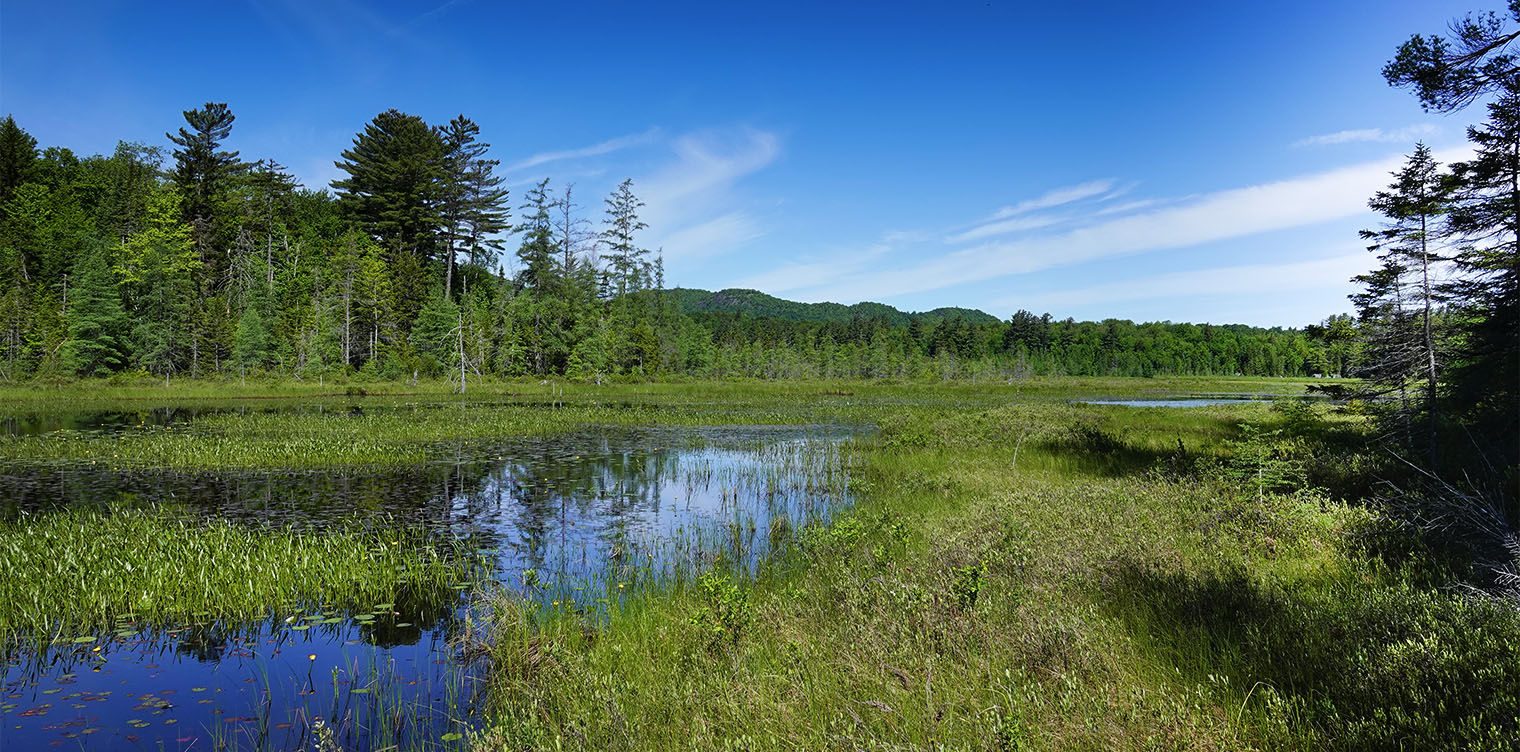
Yellow Pond Lily can tolerate sun to part shade. It grows in mucky soil in water less than about seven feet deep, on the edges of ponds and lakes. It is also found in marshes and slow-moving rivers and streams. It is often seen near White Water Lily.
In the Adirondack Mountains, Yellow Pond Lilies are found in several ecological communities, including:
- Bog Lake/Pond
- Deep Emergent Marsh
- Eutrophic Dimictic Lake
- Eutrophic Pond
- Marsh Headwater Stream
Yellow Pond Lily can be seen on Heron Marsh at the Paul Smith's College VIC, from the Heron Marsh Trail, Woods and Waters Trail, and Logger's Loop Trail. It is also found in the slow-moving water of Barnum Brook, on the Boreal Life Trail. You can also find Yellow Pond Lilies growing in the marshy areas near the southern end of the Bloomingdale Bog Trail.
References
Michael Kudish. Adirondack Upland Flora: An Ecological Perspective (The Chauncy Press, 1992), pp. 23-28, 106.
Michael Kudish. Paul Smiths Flora II: Additional Vascular Plants; Bryophytes (Mosses and Liverworts); Soils and Vegetation; Local Forest History (Paul Smith's College, 1981), pp. 6-7.
New York Flora Association. New York Flora Atlas. Common Yellow Pond Lily. Nuphar variegata Durand. Retrieved 28 February 2018.
New York Flora Association. New York Flora Atlas. Nymphaeaceae. Retrieved 28 February 2018.
New York Flora Association. New York Flora Atlas. Nuphar. Retrieved 28 February 2018.
Integrated Taxonomic Information System. Nuphar variegata Durand. Retrieved 28 February 2018.
J. T. Kartesz. The Biota of North America Program (BONAP). 2015. Taxonomic Data Center. Chapel Hill, N.C. Nuphar variegata. Retrieved 28 February 2018.
United States Department of Agriculture. The Plants Database. Varigated Yellow Pond-lily. Nuphar lutea (L.) Sm. ssp. variegata (Durand) E.O. Beal. Retrieved 28 February 2018.
United States Department of Agriculture. NRCS National Plant Data Center & the Biota of North America Program. Plant Guide. Yellow Pond-lily. Nuphar lutea (L.) Sm. Retrieved 28 February 2018.
Flora of North America. Nuphar. Retrieved 28 February 2018.
Flora of North America. Nuphar variegata Durand. Retrieved 28 February 2018.
NatureServe Explorer. Online Encyclopedia of Life. Yellow Cow-lily. Nuphar lutea ssp. variegata. Retrieved 28 February 2018.
Margaret B. Gargiullo. A Guide to Native Plants of the New York City Region (New York City Department of Parks & Recreation, 2007), p. 122.
Native Plant Trust. Go Botany. Bullhead Pond-lily. Nuphar variegata Dur. Retrieved 27 February 2020.
New York State. Department of Environmental Conservation. New York Natural Heritage Program. Ecological Communities of New York State. Second Edition (March 2014), pp. 24-25, 35-36, 42-43, 47-48. Retrieved 17 October 2015.
New York Natural Heritage Program. 2020. Online Conservation Guide for Bog Lake/Pond. Retrieved 27 February 2020.
New York Natural Heritage Program. 2020. Online Conservation Guide for Deep Emergent Marsh. Retrieved 27 February 2020.
New York Natural Heritage Program. 2020. Online Conservation Guide for Marsh Headwater Stream. Retrieved 27 February 2020.
New York State. Adirondack Park Agency. Preliminary List of Species Native Within the Adirondack Park Listed Alphabetically by Scientific Name and Sorted by Habit. Volume 1. Updated 10.23.2006, p. 61. Retrieved 26 January 2017.
University of Wisconsin. Flora of Wisconsin. Nuphar variegata Durand. Retrieved 28 February 2018.
Minnesota Wildflowers. Nuphar variegata (Yellow Pond-lily). Retrieved 28 February 2018.
Illinois Wildflowers. Vertebrate Animal & Plant Database. Nuphar variegata. Bullhead Pond-lily. Retrieved 28 February 2018.
Illinois Wildflowers. Plant-Feeding Insect Database. Nuphar variegata. Bullhead Pond-lily. Retrieved 28 February 2018.
Lady Bird Johnson Wildflower Center. Nuphar lutea ssp. variegata. Retrieved 28 February 2018.
iNaturalist. Adirondack Park Observations. Variegated Pond-Lily. Nuphar variegata. Retrieved 27 February 2020.
Anne McGrath. Wildflowers of the Adirondacks (EarthWords, 2000), p. 80, Plate 23.
Roger Tory Peterson and Margaret McKenny. A Field Guide to Wildflowers. Northeastern and North-central North America (Houghton Mifflin Company, 1968), pp. 100-101.
Doug Ladd. North Woods Wildflowers (Falcon Publishing, 2001), p. 129.
Lawrence Newcomb. Newcomb's Wildflower Guide (Little Brown and Company, 1977), pp. 176-177.
Meiyin Wu & Dennis Kalma. Wetland Plants of the Adirondacks: Herbaceous Plants and Aquatic Plants (Trafford Publishing, 2011), p. 152.
Donald D. Cox. A Naturalist's Guide to Wetland Plants. An Ecology for Eastern North America (Syracuse University Press, 2002), p. 67.
David M. Brandenburg. Field Guide to Wildflowers of North America (Sterling Publishing Company, Inc., 2010), p. 356.
Timothy Coffey. The History and Folklore of North American Wildflowers (FactsOnFile, 1993), pp. 5-6.
Wilbur H. Duncan and Marion B. Duncan. Wildflowers of the Eastern United States (The University of Georgia Press, 1999), p. 12, Plate 40.
National Audubon Society. Field Guide to North American Wildflowers. Eastern Region (Alfred A. Knopf, 2001), pp. 640-641, Plate 262.
William K. Chapman et al. Wildflowers of New York in Color (Syracuse University Press, 1998), pp. 88-89.
Alexander C. Martin, Herbert S. Zim, and Arnold L. Nelson. American Wildlife & Plants. A Guide to Wildlife Food Habits (Dover Publications, 1951), p. 452.
John Eastman. The Book of Swamp and Bog: Trees, Shrubs, and Wildflowers of Eastern Freshwater Wetlands (Stackpole Books, 1995), pp. 203-209.
Margaret McKenny. Birds in the Garden (Grosset & Dunlap, 1939), p. 321.
Verne E. Davison. Attracting Birds: From the Prairies to the Atlantic (Thomas Y. Crowell Company, 1967), p. 173.
Steven Foster and James A. Duke. A Field Guide to Medicinal Plants and Herbs of Eastern and Central North America. Second Edition. (Houghton Mifflin Harcourt, 2000), pp. 101-102.
Bradford Angier. Field Guide to Edible Wild Plants. Revised and Updated. (Stackpole Books, 2008), pp. 270-271.
The Cornell Lab of Ornithology. Birds of North America. Subscription web site. Red-necked Grebe, Ring-necked Duck, American Black Duck, Retrieved 1 March 2018.
Iowa State University. BugGuide. Donacia; Homophoberia cristata; Galerucella nymphaeae; Bellura gortynoides; Elophila ekthlipsis; Parapoynx obscuralis. Retrieved 5 March 2018.
Allen J. Coombes. Dictionary of Plant Names (Timber Press, 1994), p. 126.
Saratoga Woods and Waterways. Disappointments and Surprises at Pyramid Lake. 30 May 2010. Retrieved 5 March 2018.
Stephen H. Jenkins and Peter E. Busher, "Castor Canadensis," Mammalian Species, No. 120, pp. 1-8.
United States Department of Agriculture. Fire Effects Information System (FEIS). Alces americanus. Retrieved 30 March 2017.
United States Department of Agriculture. Fire Effects Information System (FEIS). Species Reviews. Castor canadensis. Retrieved 29 March 2017. Retrieved 29 March 2017.
Patrick D. Moldowan et al, "Diet and Feeding Behaviour of Snapping Turtles (Chelydra serpentina) and Midland Painted Turtles (Chrysemys picta marginata) in Algonquin Provincial Park, Ontario," Canadian Field Naturalist, Volume 129, Number 4 (December 2015), pp. 403-408. Retrieved 7 February 2018.
Donald J. Padgett, Jeffrey J. Carboni and Daniel J. Schepis, "The Dietary Composition of Chrysemys picta picta (Eastern Painted Turtles) with Special Reference to the Seeds of Aquatic Macrophytes," Northeastern Naturalist, Volume 17, Number 2 (2010), pp. 305-312.
University of Wisconsin. College of Letters & Science Field Station. Waterlily Leaf Beetle (Family Chrysomelidae). 9 July 2013. Retrieved 8 February 2018.
University of Wisconsin. College of Letters & Science Field Station. Water Lily Leaf Beetle II (Family Chrysomelidae). 14 February 2017. Retrieved 8 February 2018.
Donald J. Padgett, "A Monograph of Nuphar (Nymphaeaceae)," Rhodora, Volume 109, Number 937 (Winter 2007), pp. 1-95. Retrieved 1 March 2018.
